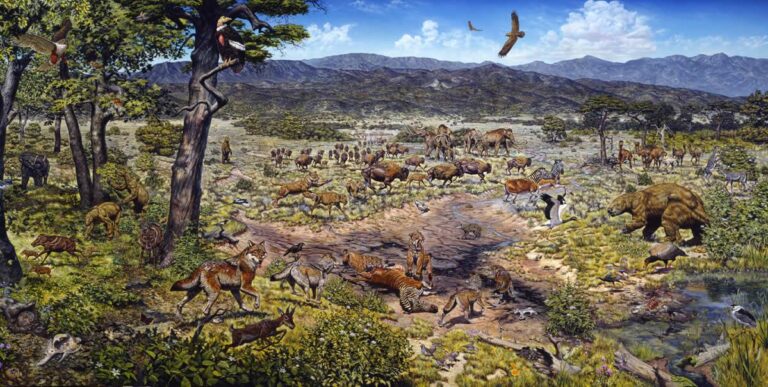Unearthing an 8.7-Million-Year-Old Fossil Ecosystem Beneath a Los Angeles High School
In a groundbreaking paleontological revelation,researchers have identified a remarkably intact fossil ecosystem dating back roughly 8.7 million years beneath a high school campus in Los Angeles. This extraordinary discovery provides an invaluable window into the Miocene epoch, unveiling a diverse array of ancient life forms that once flourished in what is now Southern California. The assemblage,considered one of the most extensive ever documented in the state,includes marine and terrestrial fossils that collectively illuminate the region’s prehistoric biodiversity and environmental conditions.
Unearthing a Prehistoric World: The Fossil Assemblage
The fossil site reveals a rich tapestry of life, preserved due to unique geological factors that favored fossilization. Among the finds are:
- Marine species: Including various mollusks,shark species,and other oceanic organisms that hint at a once-thriving coastal ecosystem.
- Land mammals: Early ancestors of horses, camels, and other herbivores that roamed the terrestrial landscapes.
- Vegetation remains: Fossilized impressions of ancient trees and shrubs that reconstruct the Miocene flora and climate.
| Fossil Category | Approximate Age | Scientific Importance |
|---|---|---|
| Shark Teeth | 8.7 million years | Evidence of ancient marine habitats |
| Proto-Horse Fossils | 8.65 million years | Insight into early terrestrial herbivores |
| Plant Imprints | 8.7 million years | Reconstruction of Miocene vegetation and climate |
Reconstructing Ancient Biodiversity and Environmental Dynamics
This fossil trove offers a rare snapshot of a complex ecosystem where marine and terrestrial environments intersected. The presence of giant shark teeth, including those from formidable species akin to the megalodon, alongside remains of dolphins and marine turtles, points to a rich coastal marine community.Together, terrestrial fossils of mammals and plants suggest a subtropical climate with lush forests and diverse wildlife.
Highlights from the site include:
- Marine fauna diversity: Sharks, dolphins, and other marine vertebrates that thrived in Miocene seas.
- Terrestrial ecosystems: Mammalian fossils and plant remains indicating warm, forested landscapes.
- Environmental indicators: Sediment analysis and fossilized pollen that provide clues about ancient sea levels and vegetation shifts.
| Fossil Type | Age (Million Years) | Ecological Role |
|---|---|---|
| Megalodon Teeth | 8.7 | Dominant marine predator |
| Dolphin Fossils | 8.7 | Marine mammal species |
| Plant Fossils | 8.7 | Primary producers shaping habitat |
| Mammalian Bones | 8.7 | Terrestrial fauna diversity |
Evolutionary Significance: Insights Into Southern California’s Past
This fossil discovery challenges and enriches our understanding of Southern California’s evolutionary history. The diverse assemblage reveals that the region was once a mosaic of coastal estuaries and forested land, shaped by dynamic climatic and geological changes during the late Miocene.These findings shed light on evolutionary processes, including speciation events and adaptive responses to environmental fluctuations.
Key evolutionary takeaways include:
- Speciation and diversification: Transitional fossils fill gaps in the mammalian lineage, illustrating evolutionary branching during this era.
- Adaptation to environmental shifts: Evidence of species adjusting to changing sea levels and climate variability, highlighting resilience mechanisms.
- Interconnected habitats: The fossil record underscores the interplay between marine and terrestrial ecosystems, influencing evolutionary trajectories.
| Evolutionary Theme | Importance | Representative Fossil |
|---|---|---|
| Speciation | Elucidates mammalian diversification | Early carnivorous mammal |
| Climate Adaptation | Reveals responses to Miocene climate changes | Coastal plant species |
| Habitat Connectivity | Highlights marine-terrestrial ecosystem links | Estuarine fish fossils |
Strategies for Protecting Fossil Heritage Amid Urban Growth
As urban progress accelerates in metropolitan regions like Los Angeles,where this invaluable fossil ecosystem was uncovered,it is imperative to implement robust preservation measures. Proactive collaboration between city planners, paleontologists, and developers is essential to safeguard these irreplaceable scientific resources.
Recommended approaches include:
- Conducting mandatory paleontological assessments before any construction activity.
- Establishing protective buffer zones around fossil-rich areas to minimize disturbance.
- Incorporating educational initiatives to raise public awareness about the significance of fossil sites.
- Employing advanced technologies such as ground-penetrating radar to map subsurface fossil deposits.
- Engaging local communities and stakeholders to foster stewardship and support for conservation efforts.
| Preservation Measure | Benefit |
|---|---|
| Pre-construction Surveys | Early identification of fossil deposits |
| Buffer Zones | Reduces risk of fossil site damage |
| Public Outreach | Builds community engagement and support |
Conclusion: Unlocking Southern California’s Ancient Secrets
The unearthing of a vast fossil ecosystem beneath a Los Angeles high school, dating back nearly 9 million years, offers an extraordinary portal into the region’s distant past. As ongoing research continues to analyse these well-preserved remains, our comprehension of California’s prehistoric environments and the evolutionary history of its flora and fauna will expand considerably. This remarkable discovery not only reshapes local geological narratives but also highlights the hidden paleontological treasures that urban landscapes can conceal, emphasizing the importance of integrating scientific preservation within city development plans.




